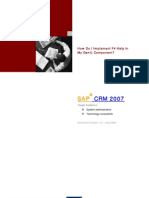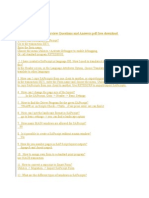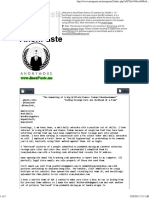Pricing in Sap CRM
Pricing in Sap CRM
Uploaded by
Tathagata DuttaCopyright:
Available Formats
Pricing in Sap CRM
Pricing in Sap CRM
Uploaded by
Tathagata DuttaOriginal Title
Copyright
Available Formats
Share this document
Did you find this document useful?
Is this content inappropriate?
Copyright:
Available Formats
Pricing in Sap CRM
Pricing in Sap CRM
Uploaded by
Tathagata DuttaCopyright:
Available Formats
Postprocessing Customizing Data
Use
The Customizing download is not able to convert all data from the SAP ECC format to the SAP CRM format. Report /SAPCND/RV12N001 carries out a type of postprocessing, and completes the conversion from SAP ECC- to SAP CRM format. It also generates all objects that are required for the condition technique. The converted Customizing is used as a basis. The most current version of the description for report /SAPCND/RV12N001 can be found in the OSS Note 398078.
Activities
Carry out the Customizing download. First step: Conversion of Customizing from SAP ECC- to SAP CRM format with the report /SAPCND/RV12N001. This program carries out the following steps: Corrects Customizing. Calls up the Business Add-In (BADI) /SAPCND/CORR_CUST. This BAdI contains the method AFTER_CORRECTION with which you can make changes to the previously corrected Customizing. Generates objects of the condition technique (for example, condition tables for CRM Enterprise and the CDB). Issues a log (the log is a function of the application log). Second step: Analysis of converted Customizing. Which pricing procedures do I want to support in SAP CRM? Which condition types, access sequences and condition tables must be consistent in CRM? The report PRCC_TRACE_COND_PP is available for the consistency check. Third step: Find out if anything is inconsistent by comparing the IMG settings in SAP ECC with the IMG settings in SAP CRM. Fourth step: Make this all possible with the help of field mapping for the download. (To adopt user-defined fields, see the IMG under Customer Relationship Management Basic Functions Pricing Define Settings for Pricing Adopt User-Defined Fields). Fifth step: Repeat Customizing download and steps 1 to 4 until data is consistent. Sixth step: Delete Customizing that is not required using report /SAPCND/RV12N001. Seventh step: Transport Customizing into the subsequent systems.
Notes:
You can find the most up-to-date help on analyzing errors during data transfer in the OSS System under SAP Composite Note 314542. When exactly do I have to execute report /SAPCND/RV12N001? After each Customizing download. Otherwise never. Not even after upgrade to a new release or after importing a service pack. Which options do I need to set in report /SAPCND/RV12N001, and when? Three phases: Correction of Customizing: Enter CRM, BBP and TAX in the Application field. Enter the values PR and FG in the Usage field. If the fields for application and usage are left empty, values for the application and usage are read out of table CND_MAPC_CNV_UA. Leave the field for the condition table ID blank and switch off all options except for the Customizing conversion. Then execute the report. Another note: The error messages that now appear can be ignored for the moment. As described above, one of the next steps is to find out which of the many records that were downloaded
from SAP ECC are actually required in SAP CRM. Only the required Customizing needs to be error-free. The remainder can be deleted at a later stage. Generation of condition technique objects: The fields for the application, usage and table number can be left empty here. All generation options must be switched on as options (the uppermost of the three blocks) and all options in the middle and lower block must be switched off. Note: The indicator for Customizing conversion must not be switched on. This is not only because conversion has already taken place; since Customizing is still inconsistent, no generation takes place if this indicator is set. Deletion of inconsistent Customizing: Once you have ensured that the Customizing required in CRM is consistent, the indicator for deleting remaining inconsistent Customizing can be set. Do not enter anything in the fields for the application, usage or table number and make sure that all other options are switched off. I have carried out a new Customizing download. Do I need to execute report /SAPCND/RV12N001 again? Yes, the first two steps at least. Do the first two steps really need to be executed again after a new Customizing download? The objects have already been generated once. The Customizing download completely replaces the previously downloaded Customizing. Information that is only available in SAP CRM and was determined during conversion or generation is also lost. The report must be executed in any case with steps one and two. Pricing or condition maintenance is not working properly in my system. You have executed report /SAPCND/RV12N001. After this it was working. The problem reoccurs and you try to execute the report again, but this does not solve the problem. What has gone wrong? Condition tables may be inactive. This does not mean the generated database tables but the condition table object itself. The first generation run probably activated the condition table. A condition table is active if Customizing is consistent and all generated objects are active. You can see if this is the case using table /SAPCND/T681. If the field GESTA has a value of 5 for a condition table, this table is active and is used for pricing and condition maintenance. If the value is not 5 (inactive), the condition table is not available for applications. If the first report run activated the condition table, further generation runs do not bring any new results. The problem is being caused by something else. How can I find out the name of a generated database table in which the data for a condition table was saved? You can use function module /SAPCND/CN_TABLE_NAME_SET to determine the names of the generated objects. Not all objects are database tables.
You might also like
- Project Report No. 3Document24 pagesProject Report No. 3GST REGISTRATION67% (3)
- Implementing Integrated Business Planning: A Guide Exemplified With Process Context and SAP IBP Use CasesFrom EverandImplementing Integrated Business Planning: A Guide Exemplified With Process Context and SAP IBP Use CasesNo ratings yet
- ABAP Objects in Action - Screen Programming With The Control FrameworkDocument19 pagesABAP Objects in Action - Screen Programming With The Control FrameworkaloxanhNo ratings yet
- Wanda POS Administrator's GuideDocument65 pagesWanda POS Administrator's GuideVictor PorrasNo ratings yet
- SAP interface programming with RFC and VBA: Edit SAP data with MS AccessFrom EverandSAP interface programming with RFC and VBA: Edit SAP data with MS AccessNo ratings yet
- Sap CRM Q&aDocument15 pagesSap CRM Q&aAsheesh SinghNo ratings yet
- SAP CRM BDoc Troubleshooting Guide 2Document6 pagesSAP CRM BDoc Troubleshooting Guide 2phanichand8965No ratings yet
- Sap CRMDocument33 pagesSap CRMadhimassNo ratings yet
- Sap Web UI Design Dec 2018 PDFDocument4 pagesSap Web UI Design Dec 2018 PDFsupreethNo ratings yet
- CRM Billing Process in SAP CRMDocument3 pagesCRM Billing Process in SAP CRMkenguva_tirupatiNo ratings yet
- CRM 7 - Dropdown BoxesDocument18 pagesCRM 7 - Dropdown Boxesy_q_li9489No ratings yet
- CRM Middleware Monitoring CockpitDocument10 pagesCRM Middleware Monitoring CockpitgauryogNo ratings yet
- SAP CRM WEB UI 7.0 - Performance TestingDocument42 pagesSAP CRM WEB UI 7.0 - Performance TestingDiana SernaNo ratings yet
- Webdynpro ResumeDocument4 pagesWebdynpro ResumePradeep SatwarkarNo ratings yet
- SAP CRM Business RoleDocument4 pagesSAP CRM Business Rolethomas_akap100% (1)
- Account and Contact ManagementDocument34 pagesAccount and Contact ManagementHari Swamy50% (2)
- CRM Billing V2Document9 pagesCRM Billing V2Suresh BabuNo ratings yet
- Sap CRM BPDocument14 pagesSap CRM BPshiva_1912-1No ratings yet
- Cookbook F4 Help CRM2007Document18 pagesCookbook F4 Help CRM2007PARTH318No ratings yet
- Middleware Interview Questions W AnswersDocument6 pagesMiddleware Interview Questions W AnswersArun Singh100% (1)
- ABAP Proxy Communication ScenarioDocument17 pagesABAP Proxy Communication Scenariokavya.noriNo ratings yet
- Spau EnhDocument2 pagesSpau EnhHemanth Kumar PanagamNo ratings yet
- SAP CRM Billing Vs ECC BillingDocument2 pagesSAP CRM Billing Vs ECC BillingPraveen Kumar ShuklaNo ratings yet
- SAP ABAP Interview Questions Part 3 - Smartforms - SAP Interview Questions and AnswersDocument10 pagesSAP ABAP Interview Questions Part 3 - Smartforms - SAP Interview Questions and Answersabdul.shaikNo ratings yet
- SAP CRM Middleware Monitoring and Error Analysis For ReplicationDocument17 pagesSAP CRM Middleware Monitoring and Error Analysis For ReplicationAniruddha ChakrabortyNo ratings yet
- Debugging Techniques in SAP CRM Web UI.Document4 pagesDebugging Techniques in SAP CRM Web UI.rajesh98765No ratings yet
- Tutorials - Day 1Document40 pagesTutorials - Day 1hplee35No ratings yet
- Step by Step Guide To Develop Outbound ABAP Proxy With PDF AttachmentDocument6 pagesStep by Step Guide To Develop Outbound ABAP Proxy With PDF Attachment蔡裕峰No ratings yet
- InterviewflowDocument80 pagesInterviewflowgauravNo ratings yet
- Sap CRM Web - UiDocument7 pagesSap CRM Web - UiNaresh BitlaNo ratings yet
- SAP ABAP Scripts Interview Questions and Answers PDFDocument6 pagesSAP ABAP Scripts Interview Questions and Answers PDFRadha SheelaNo ratings yet
- BDC in SAP TutorialDocument1 pageBDC in SAP TutorialSantosh PoojariNo ratings yet
- Webdynpro AbapDocument54 pagesWebdynpro AbapRachmad KurniawanNo ratings yet
- CIF Documentation PDFDocument8 pagesCIF Documentation PDFviswanadhareddy4609No ratings yet
- Adobe Interactive Forms - From SmartFormDocument6 pagesAdobe Interactive Forms - From SmartFormotracuentaaux5No ratings yet
- Customizing F4 Help in WebDocument12 pagesCustomizing F4 Help in WebpriyankguptasapNo ratings yet
- 3 Cookbook VBTYP Field Length Extension 20151023 PDFDocument14 pages3 Cookbook VBTYP Field Length Extension 20151023 PDFChamachongwe ChirembaNo ratings yet
- SAP ABAP Webdynpro Interview Questions and AnswersDocument7 pagesSAP ABAP Webdynpro Interview Questions and Answerskrrish.kalyan100% (4)
- Validate Input in SAP CRMDocument2 pagesValidate Input in SAP CRMtheagussantoso100% (1)
- Sap CRM TestingDocument4 pagesSap CRM TestingVidit AgrawalNo ratings yet
- CRM Abap Q&aDocument9 pagesCRM Abap Q&aswats145No ratings yet
- Overview of SAP CRM ModuleDocument12 pagesOverview of SAP CRM ModulePrashanth GaddamNo ratings yet
- Chapter 13 - ABAP List Viewer Output-Part 2 - SAP ABAP - Hands-On Test Projects With Business ScenariosDocument17 pagesChapter 13 - ABAP List Viewer Output-Part 2 - SAP ABAP - Hands-On Test Projects With Business Scenariosପରିଡା ରଣେଦ୍ରNo ratings yet
- Pricing Determination Procedure PDFDocument62 pagesPricing Determination Procedure PDFTaslimNo ratings yet
- Solution Browser ExportDocument619 pagesSolution Browser ExporthimanshuptlNo ratings yet
- Web UI Enhancement of Transmitting Data From Main Component To The Component of Search Help in SAP CRM 7 0Document9 pagesWeb UI Enhancement of Transmitting Data From Main Component To The Component of Search Help in SAP CRM 7 0nossucramNo ratings yet
- SiddSAP ABAP - Over9yrsDocument7 pagesSiddSAP ABAP - Over9yrssravan100% (1)
- SAP CRM Interview QuestionsDocument7 pagesSAP CRM Interview QuestionsSush PandeyNo ratings yet
- Switch Framework SAPDocument44 pagesSwitch Framework SAPKalikinkar LahiriNo ratings yet
- Demo On Customer ExitsDocument16 pagesDemo On Customer ExitsjuhireddyNo ratings yet
- Ovs PDFDocument17 pagesOvs PDFRakesh RaparthiNo ratings yet
- CRM Bdoc InfoDocument6 pagesCRM Bdoc InfoNani VolsNo ratings yet
- Matdoc CdsDocument14 pagesMatdoc CdsSai BodduNo ratings yet
- Field SymbolsDocument7 pagesField SymbolsAndrés GómezNo ratings yet
- Workflowtroubleshootingguide PDFDocument68 pagesWorkflowtroubleshootingguide PDFrajeshkothamasuNo ratings yet
- Mastering SAP ABAP: A complete guide to developing fast, durable, and maintainable ABAP programs in SAPFrom EverandMastering SAP ABAP: A complete guide to developing fast, durable, and maintainable ABAP programs in SAPNo ratings yet
- Custom Fiori Applications in SAP HANA: Design, Develop, and Deploy Fiori Applications for the EnterpriseFrom EverandCustom Fiori Applications in SAP HANA: Design, Develop, and Deploy Fiori Applications for the EnterpriseNo ratings yet
- Zsales Ter March 19Document18 pagesZsales Ter March 19Tathagata DuttaNo ratings yet
- Century Ply Business Solution Design Ver001Document22 pagesCentury Ply Business Solution Design Ver001Tathagata DuttaNo ratings yet
- Interface For Sales Order Header: Description (Sap) Interface Fields Remarks Length (Max)Document2 pagesInterface For Sales Order Header: Description (Sap) Interface Fields Remarks Length (Max)Tathagata DuttaNo ratings yet
- Es ConfigDocument36 pagesEs ConfigTathagata DuttaNo ratings yet
- Airbnb Final ReportDocument27 pagesAirbnb Final ReportNipitpon Tongpun100% (1)
- AN00201-002 CP600 HMI - How To Display A Page To Indicate Communication ErrorDocument7 pagesAN00201-002 CP600 HMI - How To Display A Page To Indicate Communication ErrorismuNo ratings yet
- Template Test Plan V10Document19 pagesTemplate Test Plan V10abap2814100% (1)
- Critical Information Infrastructures Security: Erich Rome Marianthi Theocharidou Stephen WolthusenDocument269 pagesCritical Information Infrastructures Security: Erich Rome Marianthi Theocharidou Stephen WolthusenVikasNo ratings yet
- Cs2311-Object Oriented ProgrammingDocument22 pagesCs2311-Object Oriented Programmingbalakrishnan gNo ratings yet
- SAP ECC Audit GuidelinesDocument16 pagesSAP ECC Audit GuidelinesBONo ratings yet
- Lab ResultsDocument12 pagesLab ResultsLisaNo ratings yet
- AnonPaste UnmaskingDocument5 pagesAnonPaste UnmaskingYaya FlashNo ratings yet
- 8.1.2.4 Lab - Configuring Basic DHCPv4 On A Router - SolutionDocument14 pages8.1.2.4 Lab - Configuring Basic DHCPv4 On A Router - SolutionHeelohs Sinatra50% (2)
- DLD Lab Report #7Document11 pagesDLD Lab Report #7waleedNo ratings yet
- Virtual Machines: Dr. N. Rakesh Vice Chair - Dept - of CSE Amrita School of Engineering, BengaluruDocument550 pagesVirtual Machines: Dr. N. Rakesh Vice Chair - Dept - of CSE Amrita School of Engineering, BengaluruSony SAB & Sony SET TVNo ratings yet
- Whitepaper Getting Started With Product ExperiemtationDocument17 pagesWhitepaper Getting Started With Product ExperiemtationTruica DanielNo ratings yet
- Module4.2 PM Create N1 Notification ZIW21 24.02.2013 V1.0Document28 pagesModule4.2 PM Create N1 Notification ZIW21 24.02.2013 V1.0pganoelNo ratings yet
- Pop Quiz Logic Gate and Logic CircuitDocument3 pagesPop Quiz Logic Gate and Logic CircuitayNo ratings yet
- MlProject Cse 30 37Document27 pagesMlProject Cse 30 374023 KeerthanaNo ratings yet
- Operation Manual: Valuejet Layer EditorDocument51 pagesOperation Manual: Valuejet Layer EditorPaulo Quaresma100% (1)
- Huawei TAC Trouble Ticket - U2020 MBB SMS - EMAIL NotificationDocument1 pageHuawei TAC Trouble Ticket - U2020 MBB SMS - EMAIL NotificationLindon ManehetaNo ratings yet
- Paradox MathDocument49 pagesParadox MathGabi PetrusNo ratings yet
- TopconTools 7.3Document606 pagesTopconTools 7.3Digiplott TopografiaNo ratings yet
- GRC Dashboards - Runtime Installation: Aris ConnectDocument16 pagesGRC Dashboards - Runtime Installation: Aris Connectmohammedomar1974No ratings yet
- O'Fallon Police Department: Colonel Roy Joachimstaler Chief of PoliceDocument2 pagesO'Fallon Police Department: Colonel Roy Joachimstaler Chief of PoliceJoeljar Enciso SaraviaNo ratings yet
- FDM Frequency Division Multiplexing PDFDocument2 pagesFDM Frequency Division Multiplexing PDFAnnaNo ratings yet
- How To Set Up A WRT54GS As A Repeater: Other People Are ReadingDocument5 pagesHow To Set Up A WRT54GS As A Repeater: Other People Are ReadingGilbertoReyesNo ratings yet
- Multithreading. JavaDocument8 pagesMultithreading. JavaKaveri WakchaureNo ratings yet
- LARSA4D Journal 2009-10Document8 pagesLARSA4D Journal 2009-10sukit_uiucNo ratings yet
- AVCS User Guide Orca Master v1 0Document15 pagesAVCS User Guide Orca Master v1 0Lyubomir Lazarov100% (1)
- VLSI & ASIC Digital Design Interview QuestionsDocument6 pagesVLSI & ASIC Digital Design Interview QuestionsRupesh Kumar DuttaNo ratings yet
- AON Ops Review - Azure RBAC - January 2024Document13 pagesAON Ops Review - Azure RBAC - January 2024dildakoNo ratings yet





























































































